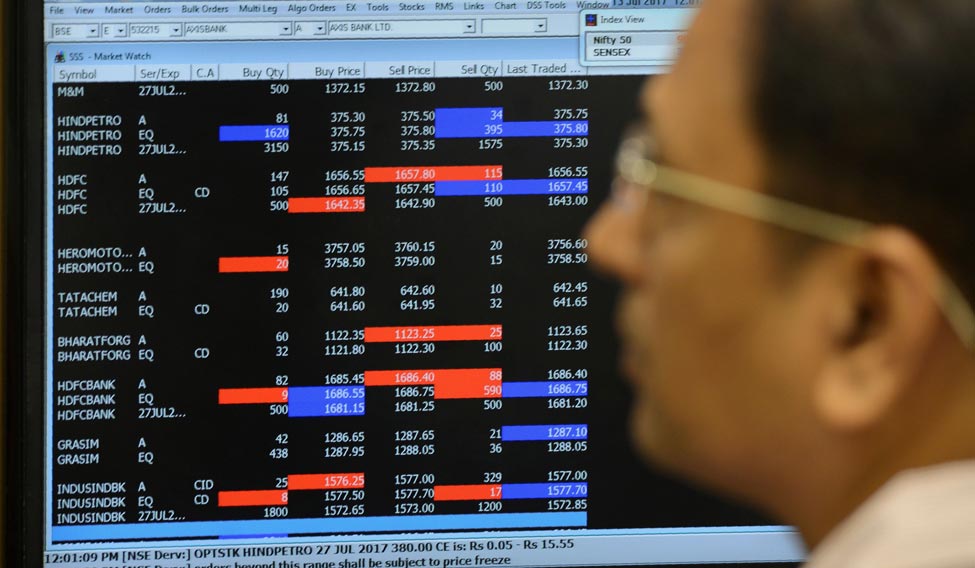The Nifty fell 2.58 per cent to end at a two-week low of 10,122. India’s GDP data, which was in line with expectations, failed to cheer markets as worries escalated that rising crude oil prices could worsen fiscal deficit. However, a missile launch by North Korea was largely ignored by investors.
OPEC’s decision to extend its oil supply cuts until the end of 2018 prompted a sharp rally of the commodity, while the rupee ended down at 64.46 against the dollar on fears of a wider fiscal deficit and continued FII outflows.
Fed Chair Janet Yellen, in her testimony before the Congressional Joint Economic Committee, repeated that she anticipates the US central bank will continue to gradually raise interest rates and trim its balance sheet. The Fed’s Beige Book economic report said the US economy grew at a modest to moderate pace through mid-November as price pressures strengthened and the labour market tightened.
Back home, lower revenue collection by the government from GST was the focal point of discussion during the week. It fell to Rs 833.46 billion during the October-November period from Rs 921 billion in September, due to lower tax rates on most commodities.
The government also attributed the lower tax collection and lesser compliance to delayed implementation of some of the main features such as invoice matching, e-way bill and reverse charge mechanism.
Most automobile companies reported strong sales growth in November on a yearly basis due to a low base, as demand was hit last year after the government’s demonetisation drive.
Seasonally, November is usually a weak month as it comes after the festive season. Sector leader Maruti Suzuki’s sales rose for the eleventh straight month, up 14.1 per cent on strong demand for its compact cars like the Ignis, Baleno and Celerio. Tata Motors’ PV sales rose 35 per cent to 17,157 units, led by its new compact SUV Nexon. M&M reported a 21 per cent increase in PV sales at 16,030 units.
On the macro front, GDP growth rate accelerated to 6.3 per cent in Q2 FY18, snapping five quarters of deceleration, on the supposed fading impact of disruptions caused by GST implementation and robust performance of manufacturing and mining sectors. One needs to see whether this is a blip or the upward movement will continue.
The RBI is likely to hold rates steady in December and February, given upside risks to inflation as well as fiscal deficit slippage, aggravated by rising oil prices and a gradual tightening of rates globally.
India’s eight core industrial output remained unchanged in October as strong growth of refinery and steel products were offset by decline in cement and natural gas.
India's fiscal deficit widened, touching Rs 5.25 trillion in October, or 96.10 per cent of the budgeted target for the financial year, as input tax credit lowered revenue receipts for the government. India’s fiscal prudence may be under the scanner now.
The Nikkei India PMI for November stood at 52.6 compared with 50.3 in October. It is the strongest improvement in business conditions in 13 months and comes on back of accelerated increase in output and new orders following the lowering of GST rates.
Macro data to watch out for in the coming week include India’s Service sector PMI, which will be declared on Tuesday.
Globally, US ISM non-manufacturing PMI data for November 2017 will be unveiled on Tuesday and US ADP nonfarm employment change data for November 2017 will be unveiled on Wednesday. Japan’s Q3 GDP data will be unveiled on Thursday and on Friday, US nonfarm payrolls data and US unemployment rate data for November 2017 will be released.
Wall Street will also be reacting to ramifications of the ongoing Michael Flynn saga and the US tax reform bill, which was passed by the senate. For domestic investors, the most important event to watch out for next week is the RBI rate review.
Markets will also start contemplating the outcome of the upcoming Gujarat election. The recent UP civic polls, which was swept by the BJP, will provide solace to the ruling party in Gujarat, where the Congress seems to be making some inroads.
Markets have broken key support levels closer to 10,200 and could slide back towards 9,800, though we may witness intermediate bounce-backs. We could be moving from a “buy on dips” to a “sell on rise” market. It would be prudent wait for a healthy correction before investing afresh.
–REUTERS





